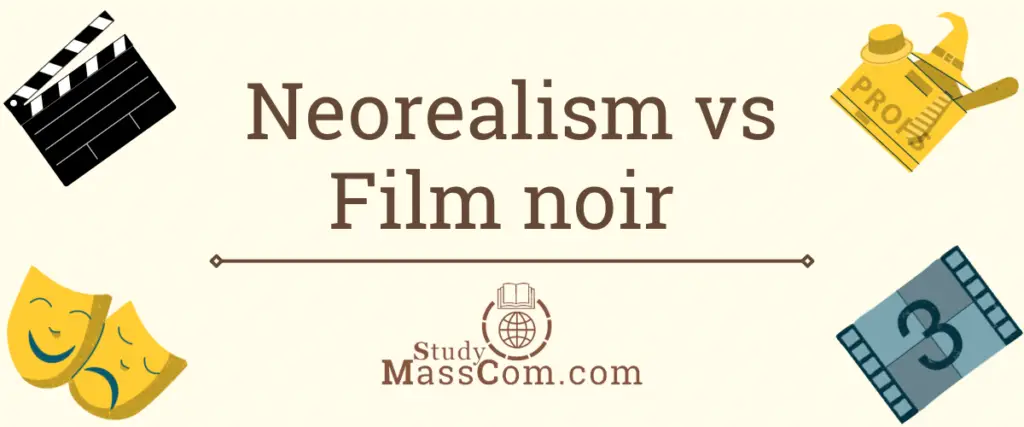Exploring Neo-Realism vs. Film Noir: A Cinematic Clash of Styles
Introduction
Discover the fascinating clash of artistic styles in cinema as we delve into the realms of Neo-Realism and Film Noir. Uncover the defining characteristics, narrative approaches, and visual aesthetics that distinguish these two influential genres.

Key Differences Between Neo-Realism and Film Noir
Here’s a chart highlighting the key differences between Italian Neo-Realism and Film Noir:
| Aspect | Neo-Realism | Film Noir |
| Origin | Post-World War II, Italy | American crime dramas of the 1940s, and ’50s |
| Focus | Everyday people and social realities | Crime, corruption, and moral ambiguity |
| Authenticity | Emphasizes authenticity and documentary-like approach | Emphasizes moody atmospheres and stylized visuals |
| Casting | Non-professional actors | Professional actors |
| Locations | Realistic and on-location settings | Often studio sets or stylized urban environments |
| Themes | Poverty, social change, human connection | Betrayal, greed, existential crises |
| Narrative Approach | Straightforward storytelling | Intricate plots with unexpected twists |
| Visual Style | Naturalistic cinematography | Low-key lighting, shadows, and dramatic compositions |
| Characters | Relatable, everyday individuals | Flawed protagonists and femme fatales |
| Overall Tone | Hopeful and empathetic | Cynical and morally ambiguous |
Please note that this chart provides a general overview of the differences between Neo-Realism and Film Noir, and there may be variations within each genre.
Understanding Neo-Realism and Film Noir
When it comes to cinematic movements, Neo-Realism and Film Noir stand out as two distinct and captivating genres. Neo-Realism emerged in post-World War II Italy, while Film Noir found its roots in American crime dramas of the 1940s and ’50s. Let’s explore the key aspects that set them apart and analyze their unique characteristics.
Neo-Realism: Authenticity and Human Experiences
Neo-Realism, also known as Italian Neorealism, focuses on presenting stories that reflect the lives of everyday people. This genre portrays social realities, often tackling themes like poverty, the aftermath of war, and the struggles of the working class. Shot on location using non-professional actors, Neo-Realism emphasizes authenticity and a documentary-like approach. Films like Vittorio De Sica’s “Bicycle Thieves” and Roberto Rossellini’s “Rome, Open City” are renowned examples of this genre.
Film Noir: Dark Shadows and Moral Ambiguity
Film Noir, on the other hand, is characterized by its moody atmospheres, shadowy visuals, and morally complex narratives. It often revolves around crime, femme fatales, and hard-boiled detectives, portraying a cynical and corrupt world. Film Noir’s distinct visual style, featuring low-key lighting and dramatic compositions, creates a sense of tension and mystery. Classic examples of Film Noir include “Double Indemnity” directed by Billy Wilder and Orson Welles’ “Touch of Evil.”
Narrative Approaches and Themes
Neo-Realism and Film Noir employ different storytelling techniques and explore diverse thematic elements.
Neo-Realism focuses on the struggles of ordinary people, often depicting their lives in a straightforward manner. It embraces a sense of hope and social change, emphasizing empathy and human connection. The narratives revolve around relatable characters caught in challenging circumstances, ultimately highlighting the resilience of the human spirit.
Film Noir narratives, on the other hand, are characterized by intricate plots, unexpected twists, and morally ambiguous characters. The stories often feature flawed protagonists who find themselves entangled in dangerous situations. Themes of betrayal, greed, and existential crises are commonly explored, leaving audiences captivated by the intricacies of the human psyche.
Visual Aesthetics: Contrasting Styles
Visual aesthetics play a crucial role in differentiating Neorealism from Film Noir. Neo-Realism favors a naturalistic approach, capturing the essence of real-life environments. The use of non-professional actors and real locations adds to the authentic feel of the films. Cinematography tends to be unobtrusive, focusing on the characters and their interactions with the world around them.
Film Noir, on the other hand, is renowned for its striking visual style. The use of chiaroscuro lighting, intricate compositions, and deep shadows adds an element of visual intrigue and heightens the sense of mystery and suspense. The visual cues in Film Noir often mirror the internal struggles and moral ambiguity of the characters.
Conclusion
Both Neo-Realism and Film Noir have left an indelible mark on the world of cinema, showcasing contrasting yet equally compelling styles. While Neo-Realism emphasizes authenticity and the portrayal of real human experiences, Film Noir captivates audiences with its dark, morally complex narratives and visually stunning aesthetics.
1. “Drive” (2011) – Directed by Nicolas Winding Refn, this stylish neo-noir crime thriller follows a Hollywood stunt driver who gets involved in a heist gone wrong. It features a brooding atmosphere, intense performances, and a memorable soundtrack.
2. “Gone Girl” (2014) – Directed by David Fincher, this psychological thriller explores themes of deception, marriage, and media manipulation. It follows the mysterious disappearance of a woman and the subsequent investigation into her husband’s involvement.
3. “Nightcrawler” (2014) – Directed by Dan Gilroy, this dark crime thriller follows an ambitious freelance videographer who captures violent crimes and sells the footage to a local news station. It delves into the morally ambiguous world of crime journalism.
4. “Sin City” (2005) – Directed by Robert Rodriguez and Frank Miller, this stylized anthology film adapts Miller’s graphic novels. It weaves together multiple interconnected stories set in the crime-ridden Basin City, known for its corrupt politicians and brutal criminal underworld.
5. “Prisoners” (2013) – Directed by Denis Villeneuve, this suspenseful thriller follows a desperate father who takes matters into his own hands when his daughter goes missing and the police fail to find her. It explores themes of morality, justice, and the lengths people will go to protect their loved ones.
Italian neorealism, characterized by its realistic depiction of everyday life and social issues, had a profound impact on the visual aesthetics of film noir. Neorealist directors such as Vittorio De Sica and Roberto Rossellini emphasized the use of natural lighting, on-location shooting, and documentary-like techniques to create a sense of authenticity. These visual elements found their way into film noir, creating a dark and gritty atmosphere that became a hallmark of the genre. The chiaroscuro lighting, shadows, and urban landscapes prevalent in film noir owe much to neorealist cinematography.
Italian neorealism, also known as neorealismo, is a film movement that emerged in Italy after World War II, particularly in the late 1940s and early 1950s. It is considered one of the most significant and influential movements in the history of cinema. Neorealism sought to present a truthful depiction of post-war Italian society and explore the lives of ordinary people through realistic narratives and filmmaking techniques.
Italian neorealism arose as a response to the social and political climate in Italy after the war. The movement rejected the glossy and artificial aesthetics of the pre-war Italian cinema and Hollywood productions, instead opting for a raw, documentary-like style. Neorealist filmmakers aimed to capture the everyday struggles, poverty, and social issues faced by ordinary Italians, often focusing on working-class characters.



